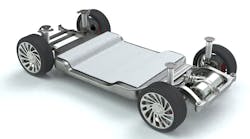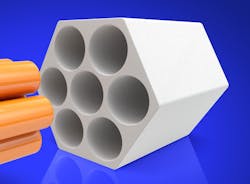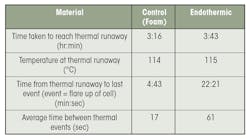Preventing Thermal Runaway in Electric Vehicle Batteries
Many car buyers shy away from electric vehicles. Their main issue, range anxiety, concerns the limited range of these vehicles. Specifically, they have worries about taking long trips, lengthy charging times, and lack of charging stations. To relieve their anxiety, carmakers are working diligently on developing more powerful lithium-ion batteries that can carry cars further and be recharged quickly.
One carmaker, Nissan, is rumored to be bringing a longer-range version of its popular Leaf car to market next year, and key to extending its range will be active thermal management. Those last two words could be critical to the success of electric vehicles as a whole. Although range is important for use, thermal management of batteries is vital to the actual safety of the battery, vehicle and, most importantly, its occupants and owners. This is due to thermal runaway, a dangerous reaction associated with lithium-ion batteries.
The simplest form of protection against thermal runaway places protective material between the battery pack and chassis.
Thermal Runaway?
Increasing the range of an electric vehicle can be done in multiple ways. This includes everything from having larger battery packs with more modules and cells to using more energy dense cells with higher capacity. However, all these approaches still leave the batteries susceptible to thermal runaway—some more so than others.
Each cell in a lithium-ion battery contains a flammable liquid electrolyte. If the cell short-circuits, the electrolyte can combust; pressure in the cell then rapidly climbs until the cell bursts and vents the flammable electrolyte.
Temperatures of the ruptured cell can increase to above 1,832°F (1,000°C). The rapid and extreme rise in temperature (thermal runaway) can easily propagate to nearby cells in a domino effect that has been dubbed thermal runaway propagation.
Thermal runaway generates smoke, fire, and even explosions. Occupants need as much time as possible to escape the vehicle if it happens.
Since 2015, when the electric-vehicle market became more mainstream, many battery-related accidents have been recorded. This includes an electric bus that caught fire after a heavy rain in Nanjing, China, with water immersion cited as the possible cause of the short circuit.
Although thermal runaway is clearly life-threatening, so far there are no global regulation in place. Whereas China has implemented the GB/T 31485 standard (Safety Requirements and Test Methods for Traction Battery of Electric Vehicle), the UN has only proposed legislation. This leaves automakers with the choice of whether to design battery packs for their cars that can deal with thermal runaway. It’s up to their own risk assessment programs to determine how likely thermal runaway incidents are.
Adding any protection in is likely to reduce the vehicle’s range because any protective materials means less space for the electricity-storing cells.
Seemingly, there is no middle ground between the range and safety. However, battery manufacturers need not compromise safety for range, or vice versa.
The next best form of protection against thermal runaway places protective material between battery modules.
Protection Methods
Companies such as Morgan Advanced Materials have been researching and developing a range of thermal management protection materials and methods over the years. They provide more time for occupants to exit a vehicle and dissipate heat to cut the chances of a thermal runaway spreading uncontrollably. Still, there is no “one-size-fits-all” approach. Every battery design is different, and protection methods must be tailored for each.
There are three levels of protection engineers can design into batteries to reduce the effects of thermal runaway in electric vehicles. Namely, these are cell-to-cell, module-to-module, and battery pack level.
Cell-to-cell protection puts an engineered material between individual cells. It is the highest level of protection, but also the most challenging due to space constraints. If a cell goes into thermal runaway, the absorption of heat and deflection of flame from the protective materials minimize thermal effects on adjacent cells.
One of the most effective materials for this type of protection are phase-change materials (PCMs), such as Morgan’s thermal insulation Energy Storage Technology (EST) Superwool Block, which can be used for certain cell formats. PCMs absorb heat from ruptured cells, turning it from a solid to a liquid or a liquid to a gas.
During the phase change, heat dissipates throughout the material. If the phase change is from solid to gas, it offers additional protection; the gas from the insulation material pushes the cell’s gases out through vents of the module, lowering the temperature quicker.
It is important to consider the cell’s shape when specifying cell protection, as different cells have different insulation needs. There are three main shapes for cells: cylindrical, prismatic, and pouch. With cylindrical batteries, insulation can be solid, but with pouch cells that expand and contract, rigid insulation cannot be used. Prismatic cells can use solid or flexible insulation materials.
Module-to-module protection puts insulation between modules to stop thermal runaway from spreading to adjacent modules. The type of insulation used depends on module size and design, and paper could be used. Notably, module-to-module protection offers significant weight savings compared to cell-to-cell protection. Lighter batteries in turn increase the range and lets the battery fit more easily accommodated in the vehicle’s design.
Pack-level protection is the simplest and most affordable type. It is aimed at giving occupants more time to exit the vehicle. It provides little protection for the battery pack itself. That said, it is far better option than no protection at all. Standard insulating paper is a common form of pack level protection, such as Superwool Plus Paper.
Automotive manufacturers have two options for thermal protection active or passive management.
Active thermal management relies on cooling technologies to add or remove energy using a substance that augments heat transfer. In electric vehicles, this includes air, liquid, and refrigerant cooling. It also involves an external device that helps dissipate heat. Active methods are generally more expensive and complex than passive techniques.
Passive methods rely upon the thermodynamics of heat transfer (conduction, convection, and radiation). Passive battery cooling includes metal heat sinks, PCMs, and specialized heat shields. These are typically less expensive than active technologies and are easier to put in place.
The best protection against thermal runaway places protective material been each cell in the battery. It is also then most challenging, because all of the protective material needed increases the car’s space constraints.
Testing Materials
Engineers at Morgan recently tested an array of protective materials, including:
- Foam: Maintains constant pressure in cells and is used within modules.
- Insulation: Thermally insulate upon exposure to heat.
- Intumescent materials: Expand in volume upon exposure to heat.
- Endothermic materials: Absorb energy upon exposure to heat like PCMs.
To illustrate how each material performed, the parameters for the test were:
- A battery module with 24 prismatic lithium-nickel-manganese-cobalt oxide (NMC) cells.
- Pairs of cells grouped to form elements, and each element separated by material sheets.
- One element within the module overcharged until thermal runaway began.
- 100% state of charge (SoC) for all cells in the module.
- All inherent safety features disabled.
Here are the results:
The test was then repeated, but with active cooling management from a cold plate for the foam and endothermic materials. Here are the results:
Based on the test results, endothermic materials are the best performing of those tested, whether that is with or without active cooling management. On the other hand, foam materials do not perform well in thermal runaway situations. However, it should be noted that the foam in this module was not designed to prevent thermal runaway and there are other foams that might perform better in thermal runaways.
The EV market is likely to increase as the costs of traditional petrochemical fuels become more expensive. With a wealth of choice in thermal management, it is evident automakers must work with materials engineers. Only by doing so can commercially viable methods can be developed, and the electric vehicle market improved.
Alysha Liebscher, business development manager, and Gary Gayman, senior R&D developer, work in the Thermal Ceramics business of Morgan Advanced Materials, a global materials engineering company headquartered in Windsor, U.K. (+44 (0) 1753-83700).






